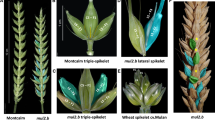Abstract
The supernumerary spikelet character of bread wheat (Triticum aestivum L.) is an abnormal spike with extra spikelet per spike. Supernumerary spikelet line 51885 was derived from the cross between octoploid Triticale and common wheat Fei 5056. The number of spikelet is over 30, and supernumerary spikelet is genetically stable. The inheritance of supernumerary spikelets in the line 51885 was genetically analyzed by crossed with seven commercial cultivars of normal head type. The results indicated that supernumerary spikelet in the line 51885 was controlled by two dominant genes which shows complementary function. Transgressive segregation for increasing the number of spikelet were observed in the four crosses, suggesting the possibility of the presence of minor effect gene(s) or modification gene(s) affecting the expression of the supernumerary spikelet in addition to the two major dominant genes. The relatively simple inheritance, feature of dominance plus the stability of expression of supernumerary spikelet in the line 51885 indicate that line 51885 could be easily incorporated in high yield breeding program in common wheat.

Similar content being viewed by others
References
Chapman SR, McNeal FH (1971) Gene action for yields components and plant height in spring wheat cross. Crop Sci 11:384–386
Gill BS, Appels R, Botha-Oberholster A-M, Buell CR, Bennetzen JL, Chalhoub B, Chumley F, Dvorák J, Iwanaga M, Keller B, Li WL, McCombie WR, Ogihara Y, Quetier F, Sasaki T (2004) A workshop report on wheat genome sequencing. International Genome Research Wheat Consortium. Genetics 168:1087–1096
Klindwroth DL, Williams ND, Duysen ME (1975) Genetic analysis of Chlorina mutants of drum wheat. Crop Sci 35:431–436
Klindwroth DL, Williams ND, Joppa LR (1990) Inheritance of supernumerary in tetraploid wheat cross. Genome 33:509–514
Koric S (1973) Branching genes in Triticum aestivum. In: Proceedings of the 4th international wheat genetics symposium, Columbia, Missouri, USA, pp 283–288
Koric S (1980) Study of branched gene complex of Triticum aestivum ssp. vulgare and its significance for wheat breeding. J Sci Agric Res Zagreb Yugoslavia 142:271–282
Li WP (1993) Argumentation of new progresses of increasing spikelets in the wheat breeding. Chin Agric Bull 9:6–9
Li WP, Zhao WM (2000) A breeding method for increasing spikelet and studies on creation of new germplasm resource in Wheat. Acta Agron Sin 26:222–230
Millet E (1983) Breeding for large number of spikelets per spike in wheat. In: Proceedings of the 6th international wheat genetics symposium. Kyoto, Japan, pp 623–628
Millet E (1986) Genetic control of heading date and spikelet number in common wheat (Triticum aestivum L.) Line ‘Noa’. Theor Appl Genet 72:105–107. doi:10.1007/BF00261463
Millet E (1987) Monosomic analysis of heading date and spikelet number in the common wheat (Triticum aestivum L.) mutispikelet Line ‘Noa’. Theor Appl Genet 74:487–492. doi:10.1007/BF00289827
Mitchell DO, Once MD, Duncan RD (1997) The World food outlook. Cambridge University Press, New York
Peng ZS, Yen C, Yang JL (1998) Chromosomal location of genes for supernumerary spikelet in breed wheat. Euphytica 103:109–114. doi:10.1023/A:1018323310621
Pennell AL, Halloran GM (1983) Inheritance of supernumerary spikelets in wheat. Euphytica 32:767–776. doi:10.1007/BF00042157
Rajaram S (2002) Prospects and promise of wheat breeding in the 21st century. In: He ZH, Zhang AM (eds) Advance of wheat breeding in China. China Science and Technology Press, Beijing, pp 38–53
Sharman BC (1967) Interpretation of the morphology of various naturally occurring abnormalities of the inflorescence of wheat (Triticum ssp.). Can J Bot 45:2073–2080. doi:10.1139/b67-224
Sun DF, Zhu XD, Wan ZB, Cai J (2000) The stability and expression in F1 generation of supernumerary spikelets in bread wheat. J Huazhong Agric Univ 19:213–218
Swaminathan MS, Chopra VL, Sastry GRK (1966) Expression and stability of an induced mutation for ear branching in bread wheat. Curr Sci 35:91–92
Tschermak E von (1914) Uber die Vererbungsweise von Art und Gattungsbastarde innerhalb der Getreidegruppe. Mitteil. Der landw. Lehrkanzeln der KK Hochschule für Bodenkultur in Wien Bd. (ii) Heft
Wei YM, Zheng YL, Zhou YH, Liu DC, Lan XJ (1999) Gliadin analysis of multispikelet wheat line 10-A and its recombinants. J Sichuan Agric Univ 17:136–139
Zheng YL, Yan C, Yang JL (1994a) Gene effects and their correlation analysis of four specific characters in the common wheat multispikelet line”10-A. Acta Agron Sin 20:536–541
Zheng YL, Yan C, Yang JL (1994b) Effects of chromosomes on grain yield per plant in the common wheat multispikelet line10-A. Hered Beijing 16(4):27–30
Acknowledgement
This project is supported by the National Natural Science Foundation of China (30671291) and the 973 project of China (2007CB109006)
Author information
Authors and Affiliations
Corresponding author
Rights and permissions
About this article
Cite this article
Sun, D., Fang, J. & Sun, G. Inheritance of genes controlling supernumerary spikelet in wheat line 51885. Euphytica 167, 173–179 (2009). https://doi.org/10.1007/s10681-008-9854-7
Received:
Accepted:
Published:
Issue Date:
DOI: https://doi.org/10.1007/s10681-008-9854-7



